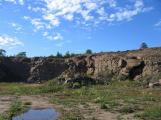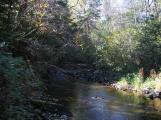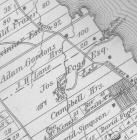1
No we don't mean that kind of stoned!What we mean is the source of building stone in Pictou is... Pictou.
One of the more persistent stories one hears, and occasionally reads, is that the stone in various buildings came from ballast brought in by ships.
While it may be possible that some ballast stone may have been incorporated in some of the infill between walls the overwhelming evidence is that Pictou quarries like Belleville, Saw Mill brook and others in the region were the main source.
Pictou's distinctive sandstone was formed in the late Carboniferous and varies in colour from grey, buff and tan.
A paper written by G. B. Dickie and produced by the Department of Natural Resources called; "Building Stone in Nova Scotia" goes into great depth examining materials and quarries throughout the province, including those in Pictou County.
(see: http://www.gov.ns.ca/natr/meb/pdf/96egs01.htm )
3
The most likely source for the ballast misconception is the actual story of McCulloch House. The brick for the home did indeed start life as ballast which was brought over by a local merchant. The merchant was intending to sell it but found no takers. He donated it to the construction of the New Reverends home. We know this from William McCulloch's biography of his father. William was an eyewitness having grown up in the house.5
In addition to expert opinion about the history and characteristics of the stone and a likely origin story, we have strong archival evidence as well. In particular for the source of stone for the jail built in 1890.7
There are two major quarries near the Town of Pictou. In fact 3 now that new one has recently opened.1. Sawmill Brook Quarry
In around 1830 John Mackenzie opened a quarry on the banks of the Saw Mill Brook, a few miles west of Pictou. The stone was both used locally and shipped to Halifax and Charlottetown. Some stone from the Sawmill Brook quarry was used in the Prince Edward Island Provincial Building in Charlottetown. The quarry's sandstone coloring was described as fresh olive to buff, with some red. It was this stone that was used to construct his home in Lyon's Brook.
In 1847 an American company, the Acadia Company, took over the quarry and built a rail spur through a tunnel under the Saw Mill Bridge and along the shore and out on a long pier to the channel. Stone from the quarry was moved along the rails by gravity and hauled to ships in the channel. The major market for this company's stone was the United States. The American Civil War led to the closing of the companies operations. A Mr. McKenzie ran the quarry for the Acadia Company and when the company closed in 1859 he continued to work the site until it permanently closed in the late 1800's.
At the time of writing little can easily be seen of the quarry's location. Thick undergrowth dominates the area with just a few cut stone scattered about the brook area. A residential subdivision now encompasses part of the Sawmill Brook quarry.
2. Pictou County Sandstone Quarry Limited
Presently operated as both quarry and producer of finished stone products is Pictou County Sandstone Quarry Ltd. Located in Hardwood Hill, Pictou County. The stone quarried at this site is tan to olive in color with fine- to medium graining. In addition to the quarrying of sandstone cutting, polishing, shaping and engraving of both sandstone and other species of rock is performed onsite.
10
3. Belleville QuarryOn the other side of Pictou was Fogo's quarry, later to be known as the Belleville quarry, owned by Adam McKeen and Sons. This quarry is located perhaps ½ a mile inland and is one of Nova Scotia's oldest. A road, now called Quarry Road, was used to transport cut stone to where Fogo's wharf, at the Pictou Harbor coast, was located. Quarry Road proves once again that in dealing with heavy stone gravity can be a wonderful thing as the road runs on a steady decline to the water. A large ramp containing cut stone can still be seen amongst the undergrowth at the site of the old wharf. As well as transporting the stone by way of water the railway also had a spur line that ran from the Fogo property to the CNR tracks located by the Pictou Shipyard.
This quarry has continuously produced sandstone, cloured fresh buff to grey, from its start in the middle 1800's till the 1940's. It is still open to a limited degree and is owned by local businessman.
Stone produced at Fogo's quarry was used in the construction of the Charlottetown legislature, the New Glasgow town hall, and of course, many of Pictou's stone buildings.
12
Page showing stone quarried for the Pictou jail (now the County office)1890
Town of Pictou, Nova Scotia






